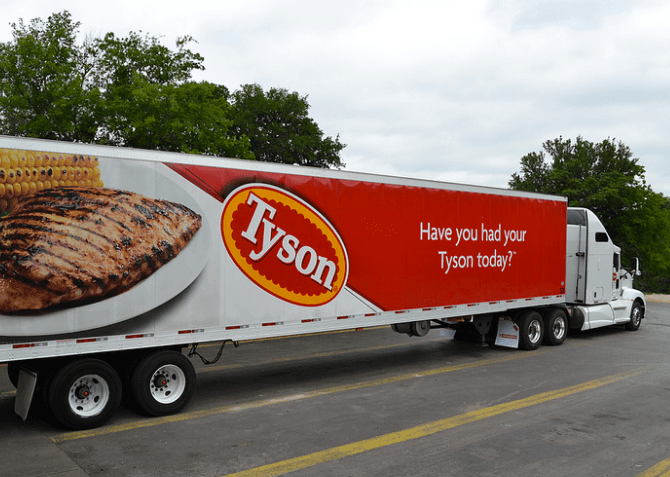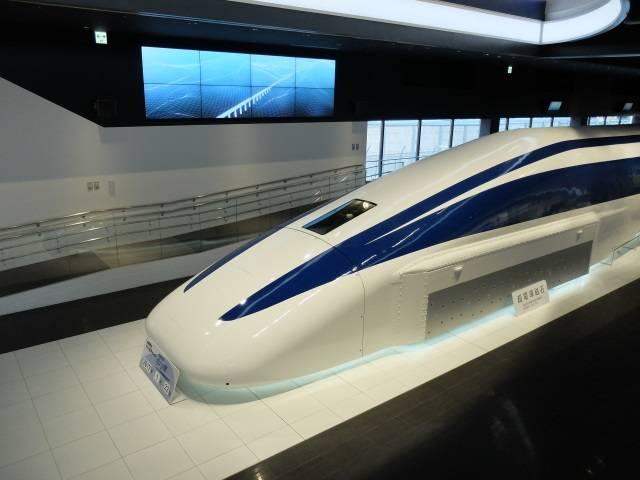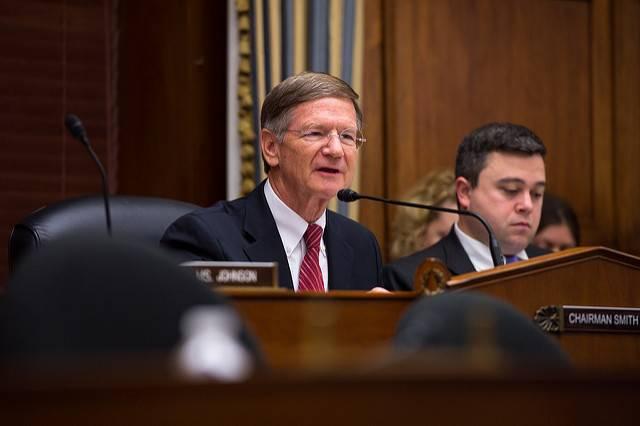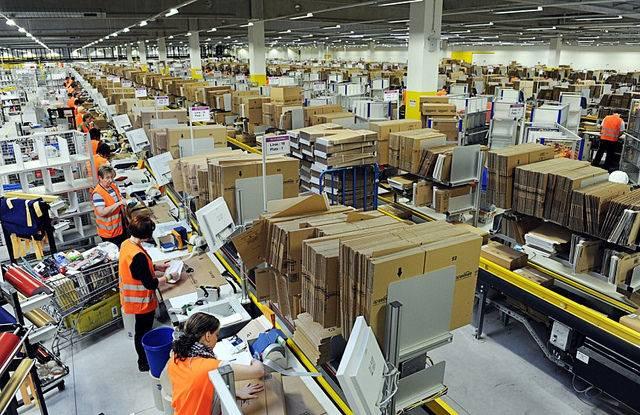SEC Investigates Tyson Foods Over Alleged Price Manipulation


Tyson Foods, the world’s largest meat processor and the largest U.S. exporter of beef, announced in a recent Securities and Exchange Commission (SEC) quarterly filing that it is under investigation over allegedly violating anti-trust laws.
The SEC probe results from a lawsuit filed by Maplevale Farms and other poultry producers against Tyson Foods and its poultry subsidiaries.
The lawsuit, which was filed last September, claims that Tyson Foods and other chicken companies conspired to limit the production of chickens while sharing data about prices and volume exclusively through a third-party data provider.
The complaint also alleges that such price-fixing dates back to January 2008, when Tyson Foods and Pilgrim’s Pride allegedly started working together to decrease the supply of broiler chickens, which comprise 98 percent of the chickens sold in the U.S.
As Denna Shanker of Bloomberg pointed out last fall, the steps that Tyson Foods supposedly took to reduce supply -- for which Maplevale Farms and other plaintiffs are suing the company -- is known as “capacity discipline” within the industry. In simple terms: By working together to limit supply, the meat industry can increase demand and therefore drive up prices.
The U.S. commercial airline industry has been investigated for using similar tactics over the years. For airlines, that means higher profits over a sustained period of time, something that long eluded U.S. carriers. For years, airlines engaged in price wars and introduced new routes in an attempt to grasp market share away from their competitors. But as any traveler knows, mergers within the air travel sector, as well as the smaller planes that fly with rarely an empty seat to spare, have resulted in higher prices.
A similar trend is now happening within the chicken industry. For decades, chicken meat prices were on a roller coaster boom-and-bust cycle, as known by anyone who remembers the frequent sales for chicken breast meat at 99 cents a pound. But chicken prices edged higher over the past several years and have not declined.
Meanwhile, regulators set their sights on the Georgia Dock, a pricing index that is little-known to consumers but has been used by retailers to negotiate with chicken producers since 1966. Critics of the Georgia Dock began to complain that Tyson Foods and Pilgrim’s Pride had too much influence over the index. And as an investigation by the New York Times revealed, U.S. Department of Agriculture (USDA) officials began to question the Georgia Dock’s pricing methodology last year.
Last August, the USDA eliminated the Georgia Dock from its weekly pricing reports. Then in November, Georgia’s agriculture department stopped publishing the Georgia Dock as officials said too few producers were contributing data.
The result, Shanker wrote in Bloomberg, is that Americans are paying as much as 50 percent more for chicken than what market forces would otherwise have dictated.
Chicken producers respond that the expensive price of corn and soy are behind chicken meat’s stubbornly high cost. Data provided by NASDAQ, however, shows that the price of corn has been on a steady decline since it peaked in mid-2012. The cost of soy also dropped precipitously in 2014, though it has recovered slightly in recent months.
Meanwhile, authors such as Christopher Leonard claim that a few companies have a stranglehold on America’s meat supply. And with government agencies such as the USDA and Department of Justice hesitant to launch expensive and complicated investigations and lawsuits, that function has largely fallen to private attorneys – hence the lawsuit Maplevale Farms has filed against Tyson Foods.
Image credit: Central Texas Food Bank/Flickr
Can a Sustainable Event Industry Create Peace, Justice and Strong Institutions?


By the Positive Impact Staff
This month's theme questions whether the sustainable event industry can create peace, justice and strong institutions in the world.
Positive Impact asked Liselore van der Heijden, deputy director of the cultural center Westergasfabriek, to discuss our theme further and to draw from her experience at an old polluted site that has been renovated into a beautiful and sustainable park in the heart of Amsterdam!
Positive Impact: Can a sustainable event industry create peace, justice and strong institutions in the world?
Liselore van der Heijden: Westergasfabriek is convinced that through the event industry, a major change can be initiated in the bigger goals in life and thus in creation of peace and justice, as these are definitely one of those bigger goals.
We would like to add emancipation, acceptance of the differences between people and respect for life in general and the planet.
But the influence of the event industry would be overestimated if we would claim that sustainable events would create peace, justice and strong institutions all over the world. The influence of events is great but not that big.
Having said that, the Westergasfabriek is the first to speak out that decreasing waste, pollution, use of energy et cetera in the event industry is key. But above all, creating awareness through events in how this and peace and justice can be realized in practice.
We believe that in the events industry, big steps can be taken and large examples can be set. Because of the positive reach and atmosphere of the event industry, subjects which can become ‘heavy’ can be illustrated in a lighter, more hopeful, free and creative environment. We would like to frame ourselves as a platform for innovation in the technical sense but also in moral perspective. Curiosity, freedom and lack of prejudice are the soils for that.
With respect to sustainability, the main aim would be to create (more) awareness at the visitors level, and get the whole supply chain involved: also the organizers, caterers, event locations, (local) government.
Positive Impact: What steps can we take to build a more sustainable events industry?
Liselore van der Heijden: The Westergasfabriek has already taken important steps, and though they may not seem big on paper, in practice these steps are truly complicated. But before we enter into details, we would like to take the opportunity to elaborate on the Westergasfabriek for the readers who do not know us, yet.
The Westergasfabriek is an old factory site, the West Gas Factory, whose foundation was initiated in 1883. The Westergasfabriek’s purpose was to provide the western part of Amsterdam with gas for lighting the city streets. In the meadows just outside the old city center, brick buildings in neo-renaissance style were raised. The high ceilings and large windows gave it an almost religious glow.
The Gasholder, the biggest round building in Amsterdam, was founded in 1903. After a very successful decennia, in the 1960s the Westergasfabriek was closed because of the discovery of natural gas in Groningen, in the northern part of the Netherlands. By then, the factory was no longer in the outskirts but part of the city, and left a heavily polluted ground to the surrounding neighborhoods.
And after some years of use as a storage by the Amsterdam municipality, the 19th-century buildings became open to the public around 1990. In a temporary phase, the buildings and surrounding space had a cultural and creative function. All sorts of festivals took place, handcraft studios and bar/restaurants were founded. This was the prelude for defining the use for the current identity of the Westergasfabriek.
But before the Westergasfabriek could take its current form, the ground in- and outside of the buildings needed to be purified. Since the buildings were neglected for decennia, restoration thereof together with the purification was too expensive for the local government. A third party, the commercial building company MAB (named BAM at that time) was asked to join, by purchasing all the real estate. This under the purchase condition that they would restore the buildings, purify the ground underneath and adhered the real estate’s purpose is creativity and cultural entrepreneurship.
The surroundings of the factory buildings were transformed in a modern park with a manifestation field and the round Gasholder as strong points of reference.
Nowadays, the Westergasfabriek is part of Amsterdam’s city center. A large part of the historic buildings can be rented for a day or more; they are empty, showing all the original leftovers of the factory. Annually, over 250 events take place, from small product launching events to more-days food (truck) festivals and high-end culture and art festivals like the Holland Festival.
And in the past years, sustainability was added by the Westergasfabriek to the cultural and creative purpose. As part of that, Westergasfabriek wrote together with the local municipality the vision document ‘The Green Manifesto.' In this Manifesto, the Westergasfabriek expresses her ambition in public ... to be carbon neutral in 2025.
This Manifesto was instrumental for the Westergasfabriek when financing of sustainable measurements was sought: In 2016 the Westergasfabriek has installed LED lights and insulated some of her buildings – both partly financed with grants and incentives by the (local) government. The insulation was achieved through roof insulations and double glass in the windows. By doing so, an enormous amount of energy is saved.
At first sight, these measurements look standard and simple. Only after one realizes that all buildings are National Monuments -- which implies that nothing from the outside may change, but also the inside needs to stay intact, and that the whole process is subject to stringent licence procedures -- that one can understand the difficulties faced in the realization.
In addition to the insolation, LED lights were installed in the buildings. Again, on paper an easy measurement, which is not subject to the license procedure. But in practice we experienced that finding the right LED in which the warmth of the building remains intact was very difficult.
Our third sustainable measurement achieved in 2016 is placing of the small waste transformer at the site of the Westergasfabriek. By giving a platform to Lara Van Druten’s Waste Transformer at the Westergasfabriek, waste from a swill of restaurants -- and future festivals and events -- will be transformed into green gas and energy. The changing the perspective that waste is an energy source implies a very interesting social innovation. After you have charged your battery during an event at the Westergasfabriek, the next day you charge your phone on the left-overs of the event.
Positive Impact: Have you personally noticed a change in your industry's approach to sustainability over the past year?
Liselore van der Heijden: Yes, I have. More and more of our customers (i.e., event organizers and their clients) have corporate social responsibilities which require them to measure how they buy in. This results in more awareness and in that they organize their events more sustainably. Also our partners are more and more ‘into sustainability.'
Positive Impact: How has Amsterdam adopted new ways to be a more sustainable event destination?
Liselore van der Heijden: We at Westergasfabriek are hosting every year more green events, that find us because of the shared sustainability purpose. And we can show what we do because of the steps we took in insulation, LED light and waste.
The local municipality of Amsterdam has concluded a covenant on ‘sustainable events’ with event organizers. The purpose is to decrease waste, use of energy through diesel generators, etcetera. It also provides the municipality grants and incentives for the coalition of the willing. In addition to that, in preparation are new Amsterdam regulations in order to regulate noise and hindrance from events and festivals in the outer space. In these regulations also sustainability goals are set.
Positive Impact: What are your hopes for the future?
Liselore van der Heijden: In our view, sustainability will become a condition for events to be allowed to take place in a high density of people, like the city of Amsterdam.
I hope that the aim and wish for sustainability is here to stay, and is not passing by like a fashion thrill; that sustainability is sustainable in itself. And that because of that it becomes a natural way of living and consuming. This is part of moral innovation, for our future generations.
Image credits: 1) Flickr/Matt Kieffer; 2) Courtesy of Liselore van der Heijden
The Changing Climate of CSR in 2017


By Nita Kirby
As the world continues to push toward sustainability and environmental protection, corporations must strive to keep up. In the last few years, corporate social responsibility (CSR) efforts have increased and mutated to cater to consumers’ increasing demands. In 2016, 64 percent of CEOs planned to increase their investments in CSR. In 2017, we can expect to see that trend continue.
We also anticipate that due to today’s political climate, CSR is beginning to change along with it and affect all aspects of our lives. In addition to increased investments and initiatives, a few more changes are beginning to take place.
1.Corporations teaming up with nonprofit partners
One of the biggest changes we can expect to see in 2017 is an increase in nonprofit organizations partnering with corporations. From a business standpoint, it makes perfect sense: Nonprofits have the cause, but not the financial and resource support. Corporations have the dollars and people, but they don't always have the bandwidth to devote to a cause. It’s win-win.Moreover, as the line between business and politics becomes ever more blurred, corporations are likely to take stances on certain issues.
Teaming up with a nonprofit that works for their preferred cause is an easy way to show what they stand for and the causes to which they are committed. In our own system, CyberGrants, a CSR and services company which processes nearly 40 percent of all corporate giving, saw sharp increases in donations to both the ACLU and IRC in the days following the administration’s executive order on immigration.
In a great example of playing to your strengths, delivery network company Roadie recently teamed up with Goodwill to provide free delivery and pick-up of donated items. Roadie will pick up any unwanted items from those wanting to donate — absolutely free — through the months of January and February. Goodwill benefits from extra donated items, and Roadie gets free press (along with doing good).
2. Increased branding via CSR
With or without CSR, company culture is becoming more important in the workplace. However, in 2017 company culture is likely to be more defined and influenced by CSR efforts.A recent survey revealed 63 percent of workers prioritize sustainability when considering employment. That means employers will need to incorporate CSR into their branding, or risk losing qualified talent.
Rather than a side project, CSR efforts are becoming entwined with companies’ core identity. CSR won’t be something a company does anymore; it will be a part of who they are.
One of the most famous companies to make CSR a party of its identity is Toms shoes. Since the beginning, Toms has donated one pair of shoes to a child in need for every pair sold. And the company's one-for-one model gave many companies the incentive to follow in its footsteps.
We see this happening already this year, with companies like Lyft, Google, Amazon and Microsoft stepping up donations to refugee-focused charities and building funds for legal battles over immigration edicts being distributed from the White House.
3. Moving to sustainable resources
According to the United Nations, if the global population reaches 9.6 billion by 2050, we would need almost three planets’ worth of resources to sustain our current lifestyle. As companies and consumers begin to realize the situation we are in, the pathway becomes clear.In 2017 and beyond, companies must make the move toward sustainable resources. Already, virgin resources are becoming more costly and more difficult to obtain. If not from a desire to do good, in the near future we will begin to see companies making this change out of necessity.
In 2015 Apple CEO Tim Cook said the company was ready to "start leading the way toward reducing carbon emissions from manufacturing.” The tech giant is now working to source 100 percent of its paper packaging from renewable resources. And this year, it holds the 84th spot on Forbes’ 100 Most Sustainable Companies -- after being absent from the list a year earlier.
4. Employees are getting more involved
The next change we see is coming from the rising percentage of millennials in the workforce. Already, 62 percent of them would take pay cuts to work for a company that’s socially responsible. But more than that, millennial employees want to be directly involved in their companies’ CSR efforts.Millennials see their workplace as an extension of their personal brand, and therefore want it to reflect the causes they care about. As more of them begin to take senior positions in the workforce, we will start to see businesses change from the top down.
Indeed, some millennials are even creating their own companies that are devoted to giving back. The startup company Love Your Melon, founded in 2012, began as class project. Its mission is to give 50 percent of its profits to children with cancer, and it quickly led to long-term success. In 2017 and beyond, we can expect to see more companies and more millennials following their example.
While millennials are leading the charge, we’re seeing top executives leaving lucrative posts due to political activity by their employers. One Oracle employee famously left his job when Oracle's CEO decided to become part of the new administration’s transition technology team.
One thing we know for certain is 2017 will continue to develop the CSR dialogue. The Internet, smartphones and social media are leading to an increasingly interconnected world. That means business, politics, personal lives and, yes, CSR initiatives are slowly melding into one entity.
While it may be tricky to navigate at first, the interconnectivity of the world means we can do more good and give more back than ever before.
Image credit: Pixabay
Ms. Nita Kirby serves as Director of Client Strategy and oversees CyberGrants’ strategic service management with a majority of its corporate clients. In addition, Nita is responsible for ensuring the success of philanthropic programs for many of CyberGrants’ key customers and oversees process improvements for how the company manages its client’s programs and relationships. This effort includes detailed benchmarking, employee engagement methodologies and financial modeling. Nita serves on numerous non-profit and volunteer boards and continues to stay engaged with the local non-profits community. Nita has worked for one of largest non-profits in the US, where she provided extensive support to some of the largest employee giving programs in the country.
With a BS in Business Administration and vast experience in program development and administrative protocol, this experience has allowed Nita to incorporate best practice processes in each of her client engagements and focus on deliverables and client satisfaction. In addition, Nita is a Lean Six Sigma certified Green Belt providing her with expanded insight into how processes affect outcomes.
What Japan Can Teach America About Sustainable Transportation


In the 1850s, when the infamous United States Navy "black ships" forced the then-isolated nation of Japan to open up to the world, one of the gifts the U.S. gave in return was a state-of-the-art, steam-powered train. In fact, one of the enduring images of that encounter is the sight of Samurai riding on the mini train, the likes of which no one in Japan had ever seen before.
At that time, it was the U.S. that had the world’s most advanced and high-tech rail system. Fast forward a century and a half, and the tables have completely turned.
While America still uses diesel engines and tracks laid in the 19th century, Japan took our gift and ran with it. The island nation now has the world’s best urban rail network and the busiest high-speed rail lines in the world. Nearly all are electric, and they are the chief reason that Japan’s per-capita GHG emissions are less than half of America's.
As U.S. states and cities look to build more sustainable transportation in order to meet set climate goals, there are a lot of things we could learn from Japan.
Investment and cooperation
One key, unique facet of Japan’s system is that it is almost entirely run by private companies. Even urban transit, such as Tokyo’s subway system, is private.To say private, of course, is a bit of a misnomer – the Japanese government plays an active role in both regulating mass transit and providing funding for innovations, such as the planned maglev system. So it is really a public-private partnership, where companies work directly with city- and national-level governments to manage, maintain and operate a state-of-the-art transit system.
This creates some surprising situations. For example, 30 different companies operate transit systems in Tokyo alone – but they all use the same payment system, making it easy for riders to use multiple systems in a single trip. Compare that to the San Francisco Bay Area, where dozens of public transit systems barely integrate and allow only limited fare overlap.
Japan’s experience shows there is a strong, positive role to be played by the private sector. Florida, which will soon see America’s first private rail system in decades go into operation, could pave the path toward more public-private partnerships in the mass transit sector.
Redundancy
Another key feature of Japan’s transportation system is that it is built to grow and evolve. Rail lines are rarely single tracks, but often have three or four tracks to allow for express service. Subway lines directly connect with commuter rail lines, allowing for seamless service across regions. Moreover, lines run by separate companies often run right alongside each other and end up at the same destination.This provides a level of redundancy rare in the U.S., where what rail systems exist are often single lines or single tracks. That leads to frequent delays or situations where freight and passenger rail share an overburdened single line, such as in Oakland, California. Making changes, as anyone knows, is extremely expensive and slow in most of the U.S.
“When looking at metro systems, the U.S. systems and the Japan system are totally different,” Taro Kobayashi, the senior representative of the Japan International Transportation Institute, told TriplePundit. “It is difficult to make a small change in the U.S. system.”
While many point to Japan’s density and unique topography as the reason trains are so prevalent, this argument also ignores one important fact: Japan is home to the world’s largest automaker, Toyota, and cars -- while not as ubiquitous as in the U.S. -- are quite important, especially outside the major cities.
Unlike most of the U.S., Japan did not focus on a single method of transportation, and it built a rail network alongside its highway system. The choice is not cars or trains – both can work together in different contexts.
Constant innovation
Having the world’s fastest, most reliable and most efficient high-speed rail system – called the Shinkansen in Japanese – is not enough. The country is embarking on an even greater, more ambitious target: the construction of the world’s first inter-city maglev line.Expected to be fully operational by 2035, the system will cut down travel time between the country’s two largest cities, Tokyo and Osaka, to just 67 minutes -- running at speeds upwards of 500 kilometers (310 miles) an hour.
In fact, technological innovation is what has kept Japan’s train manufacturers prosperous over the years.
“Japan's high-speed rail-related manufacturing industry has developed as a result of the Shinkansen, and it has been boomed due to the new demand generated by the spread of new technologies,” Yoshinori Hatta, director of the overseas high-speed rail project at the JR Central railway company, told Triple Pundit.
You see signs of this type of regrowth and innovation everywhere. In the cities, stations are constantly being expanded, new lines are being built, and older lines are undergoing maintenance. You don’t hear of situations like what’s happening in Washington, D.C., where years of neglect has left the city’s urban rail system on the brink of collapse, or in the Bay Area, where BART is only now replacing rail cars that were bought when the system was first built in the 1970s.
Time to catch up
America needs to get out of our decades-long rut and think about how to build a 21st-century, sustainable infrastructure. We are far behind not only Japan, but also Europe, Taiwan and China. But that is also an opportunity.“We are making the United States as the main target of overseas expansion,” Hatta told us. “In the U.S., there is much room to introduce high-speed passenger railroads.”
JR Central even has its eyes set on bringing the super-high-speed maglev system to Northeast Corridor, which runs along the U.S. East Coast from Boston to Washington, D.C.
“There is a very large passenger transportation demand between Washington, D.C. and New York,” Hatta explained. “If both cities are connected by maglev in one hour, we can revolutionize the lifestyle of business people in the area who have high time value.”
Rail must be part of the answer. While electric cars are growing, and many pin hopes on self-driving technologies, it is unlikely that either technology can help the U.S. achieve more than marginal transportation GHG emissions reductions on its own.
We need to build more sustainable cities, with urban rail networks that get more people around efficiently. We also need to provide alternatives to air and vehicle transport between cities. California’s high-speed rail project, when operational, could be our first modern rail system – following what Japan put in place way back in the 1970s with its first high-speed rail.
Whenever we’re ready, Japan will be there to return the favor and show us how to build a better, sustainable transportation system.
“People in the U.S. know that Japanese railways are good – but they don’t know what is good about, for example, Japanese high-speed rail. We can introduce what the Japanese government, or companies like JR Central or JR East, can do to help in the U.S.,” concluded Kobayashi of the Japan International Transportation Institute.
Image credit: Nithin Coca
Editor's Note: Nithin Coca's reporting from Japan was sponsored through a program of the International Center for Journalists and funded by the U.S.-Japan Foundation.
Patagonia Withdraws From Outdoor Retailer Event Over Lands Dispute in Utah


In the waning days of his administration, President Barack Obama used his authority under the U.S. Antiquities Act to declare almost 1.4 million acres in southeastern Utah as the Bears Ears National Monument.
Supporters of the new monument hailed the proclamation as one that would preserve some of the most sacred Native American ancestral lands in America. Opponents claimed the national monument designation limits access to these public lands and is yet another example of federal overreach.
On Friday, Utah Gov. Gary Herbert signed a resolution that challenges the national monument and calls on the Trump administration to do what it can to revoke Bears Ears’ current status. The Utah State Senate also voted on a resolution calling for the federal government to rescind Obama’s proclamation.
As a result, Patagonia announced yesterday that it will pull out of the annual summer Outdoor Retailer trade show in Utah.
Patagonia’s decision to not show up for Outdoor Retailer comes a month after the company’s founder, Yvon Chouinard, accused Herbert and other political leaders in Utah of spending “years denigrating our public lands, the backbone of our business, and trying to sell them off to the highest bidder.”
Chouinard also chided Utah’s politicians for dismissing the value of public lands and outdoor recreation, which he claims generate $12 billion in consumer spending and support 122,000 jobs in the state.
Patagonia’s exit from Utah could be followed by the entire trade show as well. For 20 years, Outdoor Retailer, one of the largest outdoor clothing and gear events in North America, held its biannual trade show in Salt Lake City. But now the Outdoor Industry Association (OIA), which operates the summer and winter shows at the Salt Palace Convention Center, says it will review proposals from other cities to host the events after its contract with Salt Lake City expires after 2018.
While the association did not explicitly mention the Bears Ears controversy, the OIA made it clear that it would “continue to educate policymakers on the economic contribution of our industry as well as our support of preserving places to recreate.”
Other outdoor gear and clothing companies could also follow Patagonia's lead. In an op-ed last month in the Salt Lake Tribune, Peter Metcalf, CEO of Black Diamond Equipment, noted that Outdoor Retailer generates at least $50 million in direct spending during its Utah events. But unless Utah's political leaders stop what he described as an "assault" on Utah's public lands, Metcalf suggested Outdoor Retailer find a new home.
"Together, Utah's political leadership has birthed an anti-public lands political agenda that is the driving force of an existential threat to the vibrancy of Utah and America's outdoor industry," Metcalf wrote.
In addition to the outdoor recreation industry’s contribution to Utah’s economy, Native American leaders have emphasized the cultural significance of the Bears Ears monument to tribes in the southwestern U.S.
In an op-ed earlier this week, Carleton Bowekaty, a Zuni tribal council member and co-chair of the Bears Ears Intertribal-Coalition, expressed disappointment at both Utah’s state leaders and its U.S. congressional delegation. Calling Obama’s designation a victory for Native Americans, Bowekaty said the new national monument will attract more visitors while boosting responsible local economic development.
Obama’s Dec. 28 proclamation preserved a smaller area of land than what its proponents had originally requested. Native American groups originally proposed an area of 1.9 million acres, which they said would have preserved over 100,000 archaeological sites. Nevertheless, the new national monument ended a campaign that dragged over 80 years to preserve these lands. And according to author Jonathan Thompson, any mineral extraction or other economic activities within the designated monument area have long ceased.
“The only existing economy threatened by the Bears Ears National Monument is the pilfering and selling of antiquities,” Thompson wrote in a recent blog post.
Image credit: Bureau of Land Management/Flickr
The House Science Committee Wants to 'Make the EPA Great Again'


U.S. Rep. Lamar Smith is wasting no time under the new administration. Long a foe of the Environmental Protection Agency, the chair of the House Committee on Science, Space and Technology held a hearing on Tuesday titled “Making EPA Great Again.”
To Smith’s critics, his antics are part of a longstanding witch hunt designed to intimidate climate scientists and NGOs. Much of Smith’s drive to hold hearings targeting climate science stem from his disdain for the various state investigations into ExxonMobil. Those investigations seek to gauge whether or not the company (long a benefactor of Smith's) suppressed nearly 30-year-old research that indicated climate change put the planet’s long-term viability at risk.
The Texas Republican claimed his hearing aimed to investigate how the EPA uses science as it develops regulations. As quoted by the Washington Post, Smith opened the hearings by declaring: “Unfortunately, over the last eight years the EPA has pursued a political agenda, not a scientific one.”
Those who testified include Kimberly White of the American Chemistry Council; Jeffrey Holmstead, a former deputy EPA administrator during the George W. Bush administration who has reaped millions from coal companies and is now a lobbyist for fossil fuel interests; and Richard Belzer, an environmental consultant. Democrats called Rush Holt of the American Association for the Advancement of Science to testify.
Much of the discussion centered around the Secret Science Reform Act of 2015, which Smith first submitted two years ago.
The legislation would prevent the EPA from accessing scientific studies that are “not transparent or reproducible.” At a first glance, that would appear to be a fair request of any organization or government agency. The problem, as many environmental groups including the Union of Concerned Scientists have pointed out, is that the bill would prohibit the EPA from using studies that contain confidential information or relate to single events, such as oil spills.
As a result, health studies that include patient data or studies of disasters such as the 2010 San Bruno explosion would not be available to EPA researchers.
“This legislation wasn’t designed to promote good science,” Dr. Andrew A. Rosenburg, director of the science and democracy for the Union of Concerned Scientists, wrote of the bill in April 2015. “It was crafted to prevent public health and environmental laws from being enforced.”
Congressional Republicans claim that EPA researchers could still conduct their research, but just not use data in the studies that would risk the agency revealing citizens’ personal information or business trade secrets.
But the Congressional Budget Office replied that such a requirement would cost the agency as much as $250 million annually – and Smith’s bill would cap the EPA’s expenditures to stay compliant with the “secret science” act at $1 million per fiscal year.
The hearing also focused on a contentious debate over whether researchers at the National Oceanic and Atmospheric Administration followed proper research protocols during a landmark climate change study.
That paper attempted to put to rest a common climate-denial claim that there has actually been a “pause” in global warming since 1998. As published in a sister paper to the British tabloid Daily Mail, the whistle-blower, NOAA scientist John Bates, claimed the study was never subjected to rigorous NOAA evaluation procedures – even though other scientists have independently verified its findings.
No credible evidence has emerged that shows NOAA scientists fudged any data, and the overwhelming opinion of climate scientists is that climate change is well underway.
Critics say Smith’s actions are just a part of Republicans’ agenda to eviscerate both climate change research and policy, further proving the GOP is caving to the U.S. fossil fuel industry.
“No one should forget that Lamar Smith and his Republican colleagues were using ‘alternative facts’ in the House Science Committee before the Trump administration made them popular,” said Liz Perera, climate policy director of the Sierra Club, in a written statement.
“Yelling at science will never change its findings that climate change is a very real threat to every one of our communities. This is another incident of oil-soaked Republican politicians burying their heads in the sand while the seas are rising, and we ought to all be very concerned.”
Meanwhile, three time zones away from Capitol Hill, lawmakers have not forgotten about ExxonMobil and its alleged cover-up of climate change research. At least 18 Democratic members of California’s U.S. House delegation have urged the state’s new Attorney General Xavier Becerra to continue the investigation of the company opened by his predecessor and now U.S. senator, Kamala Harris.
Image credit: Flickr/NASA HQ Photo
No, Federal Scientists Didn't Fake Climate Data


Editor's Note: A version of this post was first published on the World Resources Institute (WRI) blog.
By Kelly Levin and Rhys Gerholdt
The climate-denier engine is revving up again. Last weekend an article in the Mail on Sunday, a sister publication of the well-known British paper the Daily Mail, attempted to cast doubt on the strength of climate science. It’s now been taken up by the U.S. House Science Committee, which has been prone to promoting more climate denial than sound science in recent months.
The news article doesn’t just misinform; it is not grounded in facts.
At issue is a groundbreaking 2015 article in the journal Science by scientists from the National Oceanic and Atmospheric Administration (NOAA) that showed the alleged “pause” in global warming during the first years of the 21st century never happened.
The peer-reviewed article by NOAA’s Thomas Karl and colleagues found the so-called “warming slowdown” was not substantiated by updated data. In fact, temperatures continued to rise after the year 2000 at about the same rate as they had since 1950.
The article in the Mail on Sunday was based on a blog post by retired NOAA researcher John Bates and claimed the Science article was rushed into publication to influence the December 2015 Paris climate agreement -- and that it was based on research that had not gone through a proper vetting process.
The author of the Mail on Sunday news article, David Rose, has a history of publishing sensationalized articles that respected scientists have found to be false and misleading. In the following, we summarize three main reasons that the Mail on Sunday article is inaccurate.
1. Multiple lines of evidence confirm there was no “pause” in global warming
The Science article builds on a large body of research, including many other datasets that validate the main finding that there has been no “pause” in global warming through the latter part of the 20th and early 21st centuries.
Zeke Hausfather and colleagues published an article in Science Advances which verifies the NOAA datasets, comparing them to independently collected records created from high-quality instruments (buoys, satellite radiometers and Argo floats). Other researchers have come to the same conclusions.
While the Chairman of the House Science committee cited Bates’ blog post as proof that NOAA played “fast and loose with data,” Bates flatly refuted that in an interview with E&E, saying this “is not an issue of tampering with data.”
2. The news article itself manipulates data comparisons
The Mail on Sunday article includes a chart that appears to show a differential in data between NOAA and the Hadley Centre for Climate Prediction and Research in the United Kingdom.
However, as Hausfather points out, this effect is almost entirely due to using two different baselines to create the appearance of inconsistency. When this discrepancy is corrected, the difference in recent years – the core of Rose’s argument – vanishes.
3. The Science article was not rushed, and the Paris Agreement was not dependent on any one study
The article in Science met the publication’s rigorous review requirements, and the authors made their data available to other researchers.
Of course, the scientific community has a long-established process for disputing published findings. If there are really issues with a scientific study, they should be explored through the peer-review process.
In this case, multiple peer-reviewed studies independently validated the article’s findings. The editor-in-chief of Science made it clear that publication of the study was not rushed, and he called this accusation “baseless and without merit.”
Moreover, the Paris climate agreement was not based on one study. It was built upon years of negotiations, drawing on a mountain of research from the scientific community. To say that achieving the Paris agreement was due to one scientific article being published months before the negotiations is to discount decades of work by thousands of scientists and policymakers around the globe.
By the time negotiators reached Paris, 188 countries had already submitted national climate plans. The idea that this study prompted countries to overcome lingering doubts about the science defies logic. And on Tuesday, the media outlet Climate Home reached out to 10 climate envoys and ministers involved in the Paris climate summit and found that “no one said this report made an iota of difference to its result.”
The foundation of climate change science is built on a large body of work, and our understanding of the basics of climate change goes back over 150 years. Climate deniers will continue to spread misinformation, but we cannot run from the fact that the world is warming. Without a sustained response, the impacts will undoubtedly get far worse.
Image credit: Flickr/Bill Green
Kelly Levin is a senior associate with the World Resources Institute’s major emerging economies objective. She leads WRI’s Measurement and Performance Tracking Project, which builds capacity in developing countries to create and enhance systems that track emissions reductions associated with low-carbon development goals.
Rhys Gerholdt is the Communications Manager for the Global Climate Program at World Resources Institute. He brings expansive knowledge of WRI’s issues and skills as a communications strategist, with more than eight years of communications experience, and six years with environmental organizations.
A Smarter City is The Smartest Gift to Give


Editor’s note: This post is a follow-up to our recent Twitter chat with AT&T Smart Cities, BSR, Hydropoint Data Systems and SMARTATL. In case you missed it, you can catch a recap here.
By Jori Mendel, AT&T Smart Cities
I was at a friend’s birthday party recently and noticed something interesting about the presents he received from guests. The standard bottle of wine or tickets to a ball game don’t cut it anymore. The trendy gifts these days are gadgets that incorporate “smart” technologies, connect to your home and try to make life easier. You can speak to a radio to tell it to change the station, remotely lock the doors or turn off lights in your home and even buy an interactive refrigerator with touchscreen and internet access!
For years, we’ve been on a fast-moving train of technological acceleration, so receiving gifts that make your home “smart” in 2017 seems like a natural progression of where we have been headed all along. But what if we thought even bigger? What if we scaled the technology that is designed to improve the lives of individuals at home, and used it for entire cities with the purpose of tackling social and environmental challenges?
We are closer than many people realize.
AT&T recognized the opportunity in 2015 when we formed a dedicated Smart Cities Organization to expand our leadership in this rapidly growing space. Our vision for a smart city is one that uses technology to optimize how we use resources, improve peoples’ quality of life, have a positive impact on our planet and open new economic opportunities. As a company that is centered on technology, information and connectivity, applying our tools to create impactful solutions for cities seemed like a natural fit.
We started by creating a strategic framework that we’re bringing to several spotlight cities and communities around the country, including Chicago, Atlanta, Dallas and Portland, Oregon. Our vision is for AT&T’s connectivity to be the thread that securely and seamlessly connects all aspects of a city, focusing on a few core aspects that improve the lives of citizens, increase efficiencies and provide both social and environmental benefits.
We are already focusing on infrastructure to remotely monitor the conditions of roads and bridges while using sensory technology to detect leaks in city water pipes and identify upgrades faster, with more precision.
Already, AT&T is providing cellular connectivity to smart-grid devices like smart meters that allow for better outage management, helping to make energy grids more efficient and reliable. And, we’re giving municipality leadership the tools they need to see the whole picture of how their city operates with the Smart Cities Operation Center (SCOC). With the SCOC dashboard, city officials can make decisions in near real-time and keep tabs on things like power outages, water leaks, traffic issues and more – all from one location.
The building blocks are being put in place to create cities where public safety and connectivity are strengthened by universal Wi-Fi access, where smart traffic lights organize a better flow of vehicles on every road and allow for more people to get to their destination faster and where buildings monitor their own water and energy use, making adjustments as needed, while reducing environmental impacts in the process.
The world of tomorrow is being built today. By 2030, almost 60 percent of the world’s population will live in cities, and these cities currently account for 75 percent of carbon emissions on Earth. As communities confront growing societal and environmental challenges like climate change, technology will play a critical role in the future success of cities. The connectivity that AT&T provides opens a world of opportunities for improving the lives of millions.
AT&T is excited to be at the forefront of the smart cities revolution, using our solutions to connect people to each other and their communities in ways that were once unimaginable.
Image credit: Pixabay
Amazon Slammed for its Negative Impact on U.S. Jobs and Economy


Amazon is a behemoth of American commerce. The $107 billion online retail and cloud-computing giant keeps surging, though the evidence of its growth is stealth other than the packages seen on porches.
Recently, the company announced that it will build a new cargo hub in northern Kentucky, which will open with 2,000 new jobs. That is just a sliver of the 100,000 jobs the company says it will create in the U.S. over the next 18 months.
But one NGO says that Amazon’s reach has actually destroyed more jobs than it created. The results, it says, are not only fewer opportunities for employment, but also lower wages, unstable employment due to a reliance on temporary workers, and growing inequality across the U.S.
The Washington, D.C.-based Institute for Local Self-Reliance (ILSR) recently issued a report that described Amazon as a company with a “stranglehold” on the American economy. Culling data from the U.S. Census Bureau as well as from Amazon’s own annual reports and corporate website, ILSR paints a dire portrait of Amazon’s influence on the economy.
ILSR points to Illinois, where Amazon had zero employees for years in order to avoid the state’s income tax. Nevertheless, the online retailer amassed $2 billion in sales from Illinois in 2014, without employing a single person within the state’s boundaries.
The company opened its first warehouse operations in Illinois two years ago. But ILSR insists that Amazon’s job creation in Illinois is minimal compared to the revenue the state’s residents generate for the company: an estimated $1.5 million in sales for each employee. ILSR claims it takes about seven brick-and-mortar employees on average to reach that same figure.
Multiply Amazon’s impact on Illinois by how the company operates across the U.S., and ILSR says that the future of employment in retail is bleak. When counting part-time and temporary employees, ISLR estimates that Amazon employed over 145,000 people by the end of 2015. But when accounting for the approximate 295,000 jobs that have been lost at brick-and-mortar stores, ILSR maintains that Amazon was responsible for the disappearance of almost 149,000 jobs by the end of 2015.
In fairness, it is a stretch to say that all job losses in retail lay at the hands of Amazon. Some retailers’ struggles, such as those suffered by chains like Abercrombie & Fitch and Wet Seal, were due to changing consumer tastes or poor strategic decisions. Nevertheless, it is hard to deny that online retail has changed how Americans purchase items, as more shopping malls bite the dust and department store chains such as Macy’s and Sears shutter more stores.
But if retail is already a field in which many struggle to make a living, ILSR’s report suggests that many of Amazon’s employees are even worse off.
While Amazon brags about the sunshiny atmosphere at its “fulfillment centers” (a fancy MBA word for warehouse), ILSR compiled interviews with workers that describe these settings as “finely-tuned machines.” The constant monitoring by scanners, daunting packaging quotas and a punishing work culture make standing on one’s feet at a mall store seem much more appealing.
And while Amazon claims its accident, or “incident," rate is low, ILSR counters that those statistics are due to the company’s reliance on third-party contractors to fill temporary positions. Furthermore, unlike logistic companies such as UPS and FedEx, which boost temporary hiring during Christmastime, ILSR accuses Amazon of relying on temporary workers year-round.
The results for workers are dreary: ILSR’s data reveals that the pay rate at Amazon’s warehouse centers lags as much as 9 percent lower than the nationwide average for similar work.
Watch for the situation to only worsen, claims the ILSR. Amazon actually loses money on using courier services for delivery, so efforts to expand its air fleet are likely to continue. But those high-paying jobs at companies like FedEx and UPS provide a decent way of life for 1 million unionized workers and their families across the U.S.
Based on Amazon’s reputation for how it treats workers at warehouses, as well as the pressure it imposes on the company’s white-collar employees, ILSR predicts a grim future for those who make their living delivering packages. Amazon did not respond to TriplePundit's request to comment on the ISLR report.
So, how can policymakers stand up to the creeping power of mega-companies like Amazon? ILSR called on states to enforce their wage-and-hour laws, while making companies such as Amazon and their contractors jointly responsible for temporary workers’ well being.
The organization also asked states and municipalities to stop subsidizing Amazon’s warehouses, which it says has caused millions in lost revenues. ILSR even goes so far as to suggest that Amazon be broken up so that it does not have the unfair advantage of conducting business as a direct online retailer and platform for other companies.
Finally, the report urges governments to find ways to groom local businesses with programs such as loans instead of looking to lure an Amazon fulfillment center to town.
Would these efforts alone be enough to spur local retail businesses and keep logistics workers employed? Doubtful. But cities may be wise to keep an eye on companies like Amazon as they gain more power while sometimes giving little in return.
Image credit: Scott Lewis/Flickr
5 Reasons for Cities To Adopt Smart Technology


By Alice Williams
When you hear about the latest smart technology, chances are it's some new smart home device. More people protect their homes with smart security systems, check their energy use with smart thermostats, and cut utility bills with smart lights. While smart homes are a great start toward individual sustainability, a broader approach is needed to make a real impact.
Enter the smart city. These high-tech metropolises use smart technology on a large scale to streamline operations, reduce waste and address environmental concerns. They act as world leaders in efficiency and sustainability.
More municipalities, large and small, need to get on board with the smart city trend — and here are five reasons why.
1. Lower emissions
Cities that implement smart traffic management and parking systems can reduce carbon dioxide emissions by roughly 32 million metric tons annually over the next five years—equivalent to removing some 35 million vehicles from the road each year.
Smart sensors and software can reduce traffic through phased traffic lights, monitored parking spaces, traffic-tracking drones, and real-time road updates. Cities with this level of traffic outfitting are cutting residents’ time on the road, thus reducing the amount of pollution generated.
2. Smart electricity use
Cities are big energy consumers: They represent 75 percent of global primary energy consumption. But smart tech can help drastically cut that usage.
Municipal governments could, for example, make huge strides with lighting alone. Research shows that traditional lighting methods can eat up 40 percent of a municipality’s electricity bill. By upgrading to smart street lights — which use LED bulbs, sensors that adjust brightness based on weather, and monitors that turn lights on or off with traffic flow — cities can save 50 to 70 percent on electricity costs.
Beyond lighting, many interconnected technologies can sync to analysis dashboards, allowing government workers to identify areas of high use and plan for improvements accordingly.
3. Smaller overheads
Upgrades in artificial intelligence technology can save municipalities big bucks by eliminating inefficiencies in current processes. Money-saving tech advancements that are in development include smart trash bins that notify collection crews when they’re full, drones that change lightbulbs, and programs that help people sign up for automatic bill payment.
While not every process can be automated, there’s substantial room for mechanizing some of the more mundane or time-consuming tasks that eat up government workers’ time. That efficiency, in turn, could easily reduce both wasted time and wasted capital.
4. Water conservation
In urban populations, over half of water use occurs outdoors. Fortunately, smart technology can make huge inroads in outdoor water conservation. Cities can implement large-scale smart sprinkler networks, with high-tech systems that activate and deactivate based on weather and soil moisture. Smart irrigation systems can also alert maintenance crews of leakage issues to prevent wasted water from undetected leaks.
Beyond smart sprinklers, new storm water collection processes, like permeable pavement and retention ponds, can lead to further cost savings for cities. By outfitting storm water storage tanks with monitoring technology, cities can identify new processing strategies to more efficiently use water that might once have been lost.
5. Waste reduction
Smart trash cans can hold more trash by automatically compacting it, helping cities reduce trash pickup from fourteen times per week to as few as three. They can also help prevent messy trash overflow and resources needed to clean those spills.Pay as you throw (PAYT) systems — where sensors monitor the weight of residents’ trash output and charge for pickup based on those numbers — are also gaining traction. PAYT systems encourage residents to recycle and think twice about the waste they create.
As city center populations grow and environmental impacts increase, cities need to find a way to better manage urban development. If you’re not a political leader, contact your elected officials and encourage them to use smart technology in your city. Check out your city’s website for the contact information for your local city council. For larger-scale concerns that would touch on your senator or representative, use the U.S. government website to find out how to reach them.
Image credit: Pexels
Alice Williams is a communications professional with an MA in Communication Studies. In her spare time, she freelances and blogs about health and wellness over at www.honestlyfitness.com.